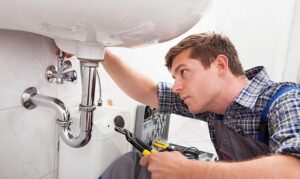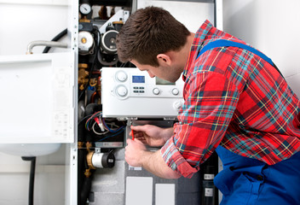When you have a plumbing emergency, such as a clogged toilet or a burst pipe, you want to find a plumber quickly. However, it’s important to choose a plumber who is reliable and experienced.
Look for a 24-hour plumber with reasonable rates. Also, make sure the plumber is insured. For more information about plumbing visit Aurora CO Water Heater Repair.

Clogged drains are more than a nuisance; they can create serious water and sanitation issues. Water that fails to pass through the system because of a blockage can go back into sinks, tubs, showers, and toilets, causing flooding and mold buildup. It can also cause plumbing fixtures to break down or stop functioning altogether. If you have a clogged drain, it’s important to call an emergency plumber right away.
The drainage systems in your home are configured a little bit like a tree: there’s a main line that branches off into the bathrooms, kitchen, and other rooms, with each branch getting smaller in diameter as it goes away from the main line. This means that a clog in one room can affect the entire house. That’s why it’s so important to prevent clogs by being vigilant about what goes down your drains.
If you notice that one or more of your drains are slow to empty, emitting bad odors, or taking longer than usual to flush, it’s time to call an emergency plumber. These are all signs of a buildup blocking the pipe, and it will only worsen over time if left untreated.
A clogged toilet is particularly dangerous because it can overflow and lead to sewage backup into your home. This can pose health risks, and it’s best to shut off your water supply until the issue is resolved.
In addition to preventing drain clogs by being careful about what goes down your pipes, it’s also helpful to have regular drain cleaning services to keep your pipes clear of sludge and debris. A professional can use special tools to clear out clogs without damaging your pipes, and they’ll also be able to advise you on how to maintain your drains better to avoid future problems.
A clogged sewer line is a more serious problem than a blocked bathroom drain. It can back up raw sewage into your home, and it’s considered a plumbing emergency because of the potential for severe water damage, health hazards, and structural damage to your home.
When pipes burst, they can cause serious water damage to your home and property. This is a true plumbing emergency that requires immediate attention from a professional plumber. However, there are some things that you can do before the plumber arrives to minimize the damage. First, shut off the water supply. You can usually find this valve near the water meter outside your house or basement. It should have a label that says “main water.” Switch it off quickly to prevent water from leaking or flooding your property.
Next, remove any valuable items from the area of the burst pipe. This includes furniture, electronics, paper documents, and other items that could get wet and ruined. Finally, dry up the area as quickly as possible by opening windows and using fans. This will help prevent the growth of mold and mildew, which can cause additional damage to your home.
A broken pipe may not seem like a pressing issue, but it can lead to severe and expensive damages in the long run. This is why it’s important to have your pipes properly installed by a licensed and experienced plumber. A bad soldering job or loose connection can easily lead to a burst pipe. It’s also important to check your pipes regularly for cracks or holes.
One of the most common signs that a pipe has burst is an unexplained spike in your water bill. This is because burst pipes often cause water to leak out, raising your water bills. To spot a burst pipe, you can check each fixture in your home by turning them on and off. Take note of the water pressure and how each fixture reacts. If you notice a sudden drop or spike in water pressure, it’s likely due to a burst pipe in your home.
If you suspect that your pipes are prone to bursting, it’s a good idea to have an emergency plumber service on retainer. This will allow you to call them immediately when a problem arises, and they can provide a quick fix before the situation gets out of hand.
If you have low water pressure, it could be a sign that you leak somewhere in your home. You can check for this by turning off all the faucets in your home and then checking your water meter. If the meter reads lower than it did before, that means water is leaking out and not getting to your home. This is a serious plumbing issue, and you will need to call in an emergency plumber for repairs.
Another common reason for low water pressure is that the branch lines in your home are too small. As you use your plumbing, the demand increases, and the branches may be unable to keep up with the supply. This can also happen due to new fixtures and appliances added to your home over time. A plumber can check for this and install a system that keeps the water pressure consistent.
It’s also important to ensure that the shut-off valves on your water meter and each fixture in your home are completely open. If they are closed even just slightly, it will impede the flow of water and cause your water pressure to drop.
A third reason for low water pressure is that the piping in your home needs to be updated or repaired. Pipes can break down or become clogged with debris over time, such as hair, grease, and food particles. You can prevent this by regularly clearing out drains and ensuring that food debris goes into the garbage and not down the drain.
In some cases, the problem may be outside of your plumbing. Your water supplier may need help with the pipes that lead to your home, or an issue at the treatment plant can reduce the amount of water they can deliver to your house. It’s worth a quick phone call to your water supplier to find out what’s going on.
If you do notice a drop in your water pressure, it’s important to have an experienced emergency plumber take a look. They can determine the cause and fix it quickly to avoid further damage.
If you’ve ever opened your water bill and felt knee-deep in sticker shock, then you probably have an emergency plumbing issue to deal with. High water bills can indicate any number of problems, but most result from a problem with your plumbing system.
The first step to figuring out the cause of your high water bill is to turn off all the sinks and faucets in your home. Then, go outside and look at your water meter. If it’s still spinning or jumping around, you leak somewhere in your home. If the meter is still moving, you may need to shut off your water main to stop the leak.
One of the most common causes of high water bills is leaking toilets. Leaking or running toilets wastes about 200 gallons of water daily and can cost you hundreds of dollars in unnecessary water charges. The good news is that a simple fix such as replacing the rubber flapper in your toilet can help to reduce these costs.
Other common sources of high water bills include leaking sink faucets and showerheads. These leaks can be harder to spot, but they are just as easy to fix. In most cases, all it takes is changing out the old faucet washer for a new one to stop this from happening.
Additionally, a leaky water pipe is another common culprit for high water bills. These leaks can occur in primary and secondary lines, delivering water to different fixtures in your home. These leaks can also lead to water damage in your ceilings, drywall and paint damage, and even mold.
Getting an abnormally high water bill is never fun, but it is important to find out the cause of the problem so that it can be fixed before it worsens. By taking the time to investigate a high water bill, you can save yourself a lot of money in the long run. If you have a problem, don’t hesitate to call a local plumbing service for assistance.


